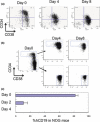Irrespective of CD34 expression, lineage-committed cell fraction reconstitutes and re-establishes transformed Philadelphia chromosome-positive leukemia in NOD/SCID/IL-2Rgammac-/- mice
- PMID: 20028384
- PMCID: PMC11159776
- DOI: 10.1111/j.1349-7006.2009.01440.x
Irrespective of CD34 expression, lineage-committed cell fraction reconstitutes and re-establishes transformed Philadelphia chromosome-positive leukemia in NOD/SCID/IL-2Rgammac-/- mice
Abstract
Stem cells of acute myeloid leukemia (AML) have been identified as immunodeficient mouse-repopulating cells with a Lin(-)CD34(+)38(-) phenotype similar to normal hematopoietic stem cells. To identify the leukemia-propagating stem cell fraction of Philadelphia chromosome-positive (Ph(+)) leukemia, we serially transplanted human leukemia cells from patients with chronic myeloid leukemia blast crisis (n = 3) or Ph(+) acute lymphoblastic leukemia (n = 3) into NOD/SCID/IL-2Rgammac(-/-) mice. Engrafted cells were almost identical to the original leukemia cells as to phenotypes, IGH rearrangements, and karyotypes. CD34(+)CD38(-)CD19(+), CD34(+)38(+)CD19(+), and CD34(-)CD38(+)CD19(+) fractions could self-renew and transfer the leukemia, whereas the CD34(-)CD38(+)CD19(+) fraction did not stably propagate in NOD/SCID mice. These findings suggest that leukemia-repopulating cells in transformed Ph(+) leukemia are included in a lineage-committed but multilayered fraction, and that CD34(+) leukemia cells potentially emerge from CD34(-) populations.
Figures






Similar articles
-
Transplantation of human umbilical cord blood cells in macrophage-depleted SCID mice: evidence for accessory cell involvement in expansion of immature CD34+CD38- cells.Blood. 1998 Mar 15;91(6):1966-76. Blood. 1998. PMID: 9490679
-
A primitive hematopoietic cell is the target for the leukemic transformation in human philadelphia-positive acute lymphoblastic leukemia.Blood. 2000 Feb 1;95(3):1007-13. Blood. 2000. PMID: 10648416
-
CD34+CD38+CD19+ as well as CD34+CD38-CD19+ cells are leukemia-initiating cells with self-renewal capacity in human B-precursor ALL.Leukemia. 2008 Jun;22(6):1207-13. doi: 10.1038/leu.2008.83. Epub 2008 Apr 17. Leukemia. 2008. PMID: 18418410
-
Expansion of human cord blood CD34(+)CD38(-) cells in ex vivo culture during retroviral transduction without a corresponding increase in SCID repopulating cell (SRC) frequency: dissociation of SRC phenotype and function.Blood. 2000 Jan 1;95(1):102-10. Blood. 2000. PMID: 10607692
-
Multilineage outgrowth of both malignant and normal hemopoietic progenitor cells from individual chronic myeloid leukemia patients in immunodeficient mice.Leukemia. 1999 Apr;13(4):618-28. doi: 10.1038/sj.leu.2401366. Leukemia. 1999. PMID: 10214871
Cited by
-
The mTOR inhibitor, everolimus (RAD001), overcomes resistance to imatinib in quiescent Ph-positive acute lymphoblastic leukemia cells.Blood Cancer J. 2011 May;1(5):e17. doi: 10.1038/bcj.2011.16. Epub 2011 May 13. Blood Cancer J. 2011. PMID: 22829152 Free PMC article.
-
Isolation, Maintenance and Expansion of Adult Hematopoietic Stem/Progenitor Cells and Leukemic Stem Cells.Cancers (Basel). 2022 Mar 28;14(7):1723. doi: 10.3390/cancers14071723. Cancers (Basel). 2022. PMID: 35406494 Free PMC article. Review.
-
Stem Cell Hierarchy and Clonal Evolution in Acute Lymphoblastic Leukemia.Stem Cells Int. 2015;2015:137164. doi: 10.1155/2015/137164. Epub 2015 Jul 6. Stem Cells Int. 2015. PMID: 26236346 Free PMC article. Review.
-
The leukaemia stem cell: similarities, differences and clinical prospects in CML and AML.Nat Rev Cancer. 2020 Mar;20(3):158-173. doi: 10.1038/s41568-019-0230-9. Epub 2020 Jan 6. Nat Rev Cancer. 2020. PMID: 31907378 Review.
-
The photosensitizer verteporfin has light-independent anti-leukemic activity for Ph-positive acute lymphoblastic leukemia and synergistically works with dasatinib.Oncotarget. 2016 Aug 30;7(35):56241-56252. doi: 10.18632/oncotarget.11025. Oncotarget. 2016. PMID: 27494842 Free PMC article.
References
-
- Bonnet D, Dick JE. Human acute myeloid leukemia is organized as a hierarchy that originates from a primitive hematopoietic cell. Nat Med 1997; 3: 730–737. - PubMed
-
- Pardal R, Clarke MF, Morrison SJ. Applying the principles of stem‐cell biology to cancer. Nat Rev Cancer 2003; 3: 895–902. - PubMed
-
- Wang JC, Dick JE. Cancer stem cells: lessons from leukemia. Trends Cell Biol 2005; 15: 494–501. - PubMed
Publication types
MeSH terms
Substances
LinkOut - more resources
Full Text Sources
Medical
Research Materials

